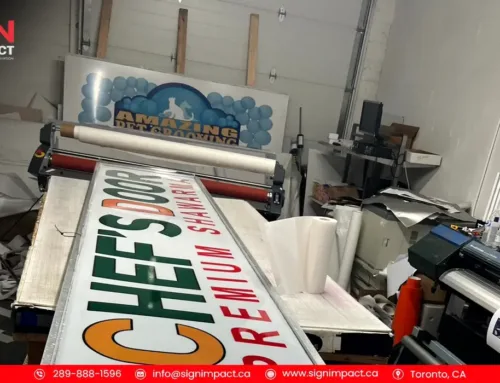Attracting attention is crucial in the cutthroat business of tourism. With so many options for places to go, places to stay, and things to do, being unique may make all the difference. Businesses in the tourism industry may effectively and visually attract more tourists, create the ideal ambiance, and convey important information by using creative signage. Here are some ways that imaginative signage may help travel agencies draw more tourists and provide unforgettable experiences.
First Impressions Matter
Signage frequently serves as a visitor’s initial interaction with a business. A well-designed sign that captures the essence of your company’s personality and style may pique interest and draw customers in. Consider how well-known tourist spots and landmarks are frequently photographed with their signage. Impressive, well-designed signage may encourage visitors to pause and investigate.
Storefront signs for business play a vital role in attracting tourists and making a memorable first impression. With eye-catching designs and themes that reflect local culture, these signs draw attention and encourage exploration. Creative storefront signage invites tourists in, boosts foot traffic, and sets the tone for an unforgettable experience.
Capturing the Spirit of Your Destination
Good signage should communicate the distinctiveness of your company and the spirit of the place. While highland retreats may choose rustic and natural textures, coastal resorts, for instance, might employ bright colours and beach-inspired decor. Visitors get a sense of the area’s attractiveness before they ever enter thanks to imaginative signage that highlights local landmarks, culture, or colours. This helps them establish a connection to the place right away.
Signage as a Social Media Attraction
Creative signage has emerged as a means of increasing online presence in the era of Instagram. Tourists frequently like taking pictures in front of unusual or humorous signage and posting them online. Businesses may encourage customers to post and tag their location on Instagram by creating an Instagram-worthy sign with eye-catching images, vibrant colours, or even clever slogans. This generates free internet advertising, which can draw in other travellers who wish to share in that idyllic moment.
Guiding Visitors with Wayfinding Signs
In tourist locations, wayfinding signs are necessary, but they don’t have to be simple. In addition to improving the visitor experience, creative directional signage may direct guests to various parts of a hotel, park, or other tourist destinations. For example, an art area can employ signs that are painted creatively to represent its creative culture, while a vineyard might utilize barrels as signposts to direct guests to various tasting rooms. Visitors are positively impacted by these additions, which enhance the immersive experience of wandering about the room.
Informative Yet Attractive Display Boards
Tourists appreciate informative signs that tell them more about the place they’re visiting. Display boards near historical sites, nature trails, or within a museum can be designed creatively to be visually appealing while still providing valuable information. Including illustrations, maps, and engaging text can help visitors connect with the content, making it feel more like storytelling than reading an informational board. This kind of signage can enhance the visitor experience by enriching their knowledge and engagement with the location.
Promotions and Offers Through Creative Signage
Another effective strategy for promoting sales, special occasions, and temporary deals is creative signage. For instance, a seaside café would use a sign fashioned like a surfboard to offer beach discounts, while a ski resort might use one made out of snowboards to market a winter package. This innovative marketing strategy attracts attention, infuses a feeling of excitement, and encourages potential customers to take advantage of deals they may otherwise overlook.
Providing Real-Time Updates via Digital Signage
Businesses in the tourist industry may update information rapidly using digital signage. Digital signage may be used by hotels, resorts, and tourist destinations to show current information such as local events, weather updates, and safety alerts. In addition to providing tourists with information, this dynamic material may draw attention to facilities, unique excursions, or eating alternatives that they may not be aware of. Personalized welcomes or welcome messages can be shown on digital signs to provide a welcoming and welcoming experience that appeals to visitors.
Nighttime Signs Gain Magic from Lighting
Even after nightfall, tourists are drawn in by illuminated signage, such as neon or LED. Lighting is essential for establishments like pubs, restaurants, and entertainment centres that depend on nighttime patrons. Innovative lighting gives the sign a magical touch and increases the company’s visibility and friendliness. For instance, a mountain resort can use fairy lights to create a fanciful atmosphere, while a restaurant by the sea would use warm, colourful lights to create a pleasant glow. In addition to improving visibility, appropriate lighting may improve visitors’ experiences in general.
Themed Signs for Seasonal Events
One way to attract tourists is by leveraging seasonal events and themes. Whether it’s a summer festival, autumn harvest, or winter holiday season, themed signs can attract visitors looking to experience something unique and seasonal. A ski resort, for instance, could use snowflake-shaped signs to advertise holiday events, while a vineyard could use grape-themed signs during the harvest season. These themed signs create a sense of excitement and encourage visitors to return for future events.
Using Language and Symbols to Connect Cultures
Tourism businesses often welcome visitors from various backgrounds, making it essential to communicate clearly. Bilingual signs or signs with universally recognized symbols ensure that all guests feel welcome and can understand important information. For example, an airport might use universal icons for directions, while a tourist attraction could display information in multiple languages. This approach is particularly helpful in large tourist spots, helping visitors feel comfortable and informed, even if they don’t speak the local language.
Showcasing Local Art and Culture
Tourists are often drawn to places that offer authentic experiences. Incorporating local art or cultural symbols into signage can help connect visitors with the destination on a deeper level. A bed-and-breakfast in an artistic town could use hand-painted signs by local artists, while a beachfront rental might incorporate indigenous patterns into its signage. By reflecting local culture, businesses not only promote a sense of community but also offer tourists a genuine and memorable experience.
Encouraging Exploration with Interactive Signs
Interactive signs invite tourists to explore more deeply. A walking tour might include QR codes on signs that link to additional information about historical spots, while a national park could have interactive maps that help visitors plan their trails. Interactive elements not only educate but also entertain, encouraging tourists to spend more time at each location. They add an element of fun, especially for families, and create a lasting impression as visitors engage with the destination in a new and exciting way.
Investing in Quality and Durability
Finally, investing in quality materials and durable design makes sure your creative signs last, even in outdoor or high-traffic areas. Since signage is often exposed to weather elements or crowds, using materials like weather-resistant metals, treated wood, or UV-protected paints ensures the sign looks good as new for longer. Durable signage maintains a polished appearance, giving a professional image and ensuring visitors have a positive impression from the first to the last.
Read Also: How LED and Digital Signs are Transforming Traditional Advertising




